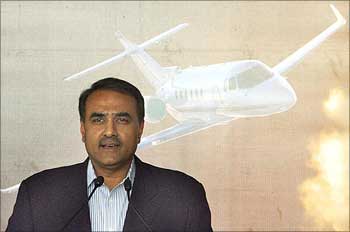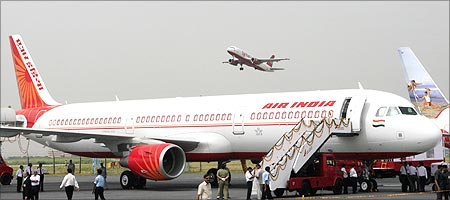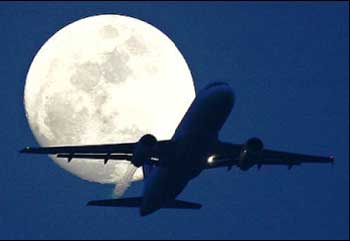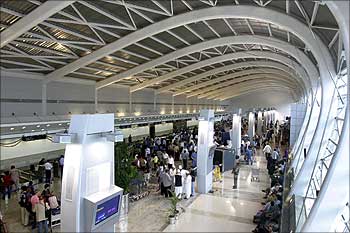 | « Back to article | Print this article |
Hope for airlines: Govt to study high fuel prices
A Group of Ministers (GoM) would be set up soon to study the impact of high jet fuel prices on the aviation industry and recommend measures to bring down its burden on the operational costs of the airlines.
This was decided on Thursday at a meeting of the Union Cabinet, chaired by Prime Minister Manmohan Singh, where Civil Aviation Minister Praful Patel made a presentation on the health of the aviation sector.
After the meeting, Patel said the GoM, to be set up soon by the prime minister, would focus on the 'very high nature' of sales tax being imposed on aviation turbine fuel (ATF) by various state governments as also its base price, which was 'much higher' than most countries.
ATF accounts for over 40 per cent of the total operational cost of an airline in India, compared with 20-25 per cent globally. Read on. . .
Hope for airlines: Govt to study high fuel prices
The minister said he had briefed the Cabinet on the need for additional capital infusion in Air India, which currently has an equity base of only Rs 145 crore (Rs 1.45 billion) and has ordered planes worth over Rs 50,000 crore (Rs 500 billion).
He also informed the meeting about the decision of Airports Authority of India to raise funds by issuing infrastructure bonds worth Rs 5,000 crore. AAI is modernising and upgrading a large number of airports throughout India, including those in Kolkata and Chennai.
Elaborating on the need for reducing the burden of ATF, the Minister said the prices of jet fuel had increased by as much as 99.6 per cent in one year.
Hope for airlines: Govt to study high fuel prices
The private airlines had recently withdrawn a strike call to protest against the high taxation on ATF and high airport charges.
Giving comparative figures, he said ATF price per kilolitre averaged between Rs 24,000 to Rs 26,000 from the entire East and Southeast Asia to Dubai, London and New York.
However, its price in states like Andhra Pradesh, which had the lowest sales tax rate of four per cent, ranged between Rs 34,000 and Rs 35,000. In Delhi, it was Rs 38,000, in Mumbai over Rs 40,000 and in Kolkata Rs 46,000.
Hope for airlines: Govt to study high fuel prices
The sales tax on ATF was zero in Andaman and Nicobar Islands, while it was 4 per cent in Andhra Pradesh, Rajasthan and Maharashtra barring the cities of Mumbai and Pune which cater to most of the flight operations.
On the higher side, the sales tax rate on jet fuel was 28-30 per cent in Karnataka, Bihar, Madhya Pradesh, Tamil Nadu and Gujarat, while it was 25 per cent in Maharashtra, West Bengal and Himachal Pradesh.
In Delhi, Goa, Haryana, Jharkhand, Chandigarh and some other states it was 20 per cent, while in Jammu and Kashmir, Uttar Pradesh and Nagaland the rate stood at 21 per cent, Patel said, adding that ATF consumption had gone up from 24,84,000 metric tonnes in 2003-04 to 44,55,000 mt in 2008-09.
Hope for airlines: Govt to study high fuel prices
India has emerged as the ninth biggest aviation market in the world, but was "still the least penetrated", he said, adding that the country accounted for 0.02 air trips per capita, compared with 0.1 in China and 2.2 in the US.
This reflects the "big opportunities" which exist in the country in the sector which is estimated to grow at the rate of 8.5 per cent per annum by 2015, the Minister said.
The overall aviation industry accounted for $14 billion in terms of revenues and investments of all airlines while Indian Railways accounted for $18 billion, he said.
While the number of planes in India had gone up from 158 in 2003-04 to 396 now, domestic flight departures per week had risen from 5,108 in 2003-04 to 11,048 in 2008-09.
Pointing out that average yields of the airlines had gone down due to the global financial downturn, Patel said the average airline ticket price had fallen from Rs 6,035 in 2003 to Rs 3,956 in 2008 while variable costs like that of ATF kept rising.
As a result, the number of flights operated by all airlines had fallen by 12.5 per cent in 2009, while passenger traffic had risen from 28.5 million in 2003-04 to 69.6 million in 2007-08 and stabilised at 70.1 million in 2008-09.




